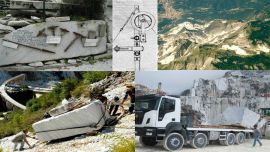Colonnata
Colonnata: All you need to know
Colonnata is an old village located on a rocky spur carefully placed at the feet of the Apuan Alps, near Carrara, famous in the entire world for its “lardo”, a truly unique product. The largest extraction complex of the Roman period discovered till now in the Apuana area, called Fossacava and located at a kilometre of Colonnata going down the valley, is definitely among the most interesting things to point out in this area.
The archaeological interest for this area was increased by the discovery, among many excavation tools, of a small statue representing Artemis holding a torch, which is now at the Archaeological Museum of Florence (Firenze). Even the village of Colonnata is of Roman origin. Its own name derives from the fact that it was born as a colony, inhabited by those who worked at the quarries (cave) and for whom a statue called the quarrymen monument (il monumento al cavatore) was built;
THE MARBLE QUARRIES (LE CAVE)
The Colonnata basin constitutes the eastern part of the Carrara marble region and holds about seventy quarries, 44 of which are still in activity, on a total surface of 500 hectares: the access to the basin is allowed by a road which goes up the valley of the Carrione torrent. In this area, on the other side of the valley, it is still possible to see the old route of the Marble Railway coming from the Miseglia basin. There is a large trench type quarry in the village of Calagio, where traces of roman excavation (escavazione romana) were once found, but however have now disappeared. In the area of Calagio, Gioia is truly interesting from an archaeological stand point as many historical pieces were found there, such as coins, epigraphs carved on the rocky walls, a small bas relief representing the god Silvano and other marble artefacts.
THE “LARDO”
The lardo is the delicatessen that has made Colonnata famous in the world: once, it was the “sandwich” of the quarrymen, who cut it into thin slices to then put it between two slices of rustic bread along with pieces of tomatoes; this “sandwich” was prepared early in the morning and was used together with the flask of wine to give the quarrymen the necessary calories to face the steep slopes and the efforts to be made to excavate. The lardo from Colonnata owes its exceptional goodness to its maturation, which origins date back to the year Thousand: in fact, the lardo, which is obtained by taking the layer of fat from the back of the pig cleaned from its greasiest part (called “spugnosa”), is put in a basin carved in a marble block (“conca”) a few hours after having been butchered. The “conca” is first vigorously rubbed with garlic and herbs (“camicia”) and then the first piece of lardo is placed on the bottom of it, above a layer of natural grains of salt, black pepper that has just been ground, fresh peeled garlic, and pieces of rosemary and sage.
The “conca” is then filled, alternating layers of lardo and layers of salt mixed with herbs. It is finally covered with a marble slab. The lardo stays in the conca for maturation for a period which varies from 6 to 10 months: the flavour of its goodness depends entirely on this maturation process. Various herbs such as cinnamon, coriander, nutmeg, clove, anise and oregano are also added to enrich its flavour.
The smell of the lardo is fragrant and its taste is delicate: it is eaten once cleaned from its skin, cut into very thin slices and then placed on fresh, warmed up bread. On the second Sunday following the Feast of the Assumption (August 15th), there is a lardo village feast (“Sagra del lardo”) which attracts thousands of tourists in Colonnata.


 Ita
Ita Deu
Deu Fra
Fra Рус
Рус



